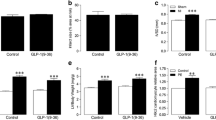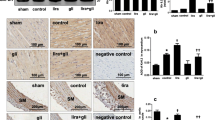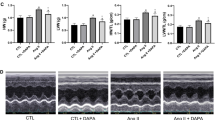Abstract
Purpose
The glucagon-like peptide-1 (GLP-1) has been shown to exert cardioprotective effects in animals and patients. This study tests the hypothesis that preservation of GLP-1 by the GLP-1 receptor agonist liraglutide or the dipeptidyl peptidase-4 (DPP-4) inhibitor linagliptin is associated with a reduction of angiotensin (Ang) II-induced cardiac fibrosis.
Methods and Results
Sprague–Dawley rats were subjected to Ang II (500 ng/kg/min) infusion using osmotic minipumps for 4 weeks. Liraglutide (0.3 mg/kg) was subcutaneously injected twice daily or linagliptin (8 mg/kg) was administered via oral gavage daily during Ang II infusion. Relative to the control, liraglutide, but not linagliptin decreased MAP (124 ± 4 vs. 200 ± 7 mmHg in control, p < 0.003). Liraglutide and linagliptin comparatively reduced the protein level of the Ang II AT1 receptor and up-regulated the AT2 receptor as identified by a reduced AT1/AT2 ratio (0.4 ± 0.02 and 0.7 ± 0.01 vs. 1.4 ± 0.2 in control, p < 0.05), coincident with the less locally-expressed AT1 receptor and enhanced AT2 receptor in the myocardium and peri-coronary vessels. Both drugs significantly reduced the populations of macrophages (16 ± 6 and 19 ± 7 vs. 61 ± 29 number/HPF in control, p < 0.05) and α-SMA expressing myofibroblasts (17 ± 7 and 13 ± 4 vs. 66 ± 29 number/HPF in control, p < 0.05), consistent with the reduction in expression of TGFβ1 and phospho-Smad2/3, and up-regulation of Smad7. Furthermore, ACE2 activity (334 ± 43 and 417 ± 51 vs. 288 ± 19 RFU/min/μg protein in control, p < 0.05) and GLP-1 receptor expression were significantly up-regulated. Along with these modulations, the synthesis of collagen I and tissue fibrosis were inhibited as determined by the smaller collagen-rich area and more viable myocardium.
Conclusion
These results demonstrate for the first time that preservation of GLP-1 using liraglutide or linagliptin is effective in inhibiting Ang II-induced cardiac fibrosis, suggesting that these drugs could be selected as an adjunctive therapy to improve clinical outcomes in the fibrosis-derived heart failure patients with or without diabetes.








Similar content being viewed by others
References
Liehn EA, Postea O, Curaj A, Marx N. Repair after myocardial infarction between fantasy and reality. J Am Coll Cardiol. 2011;58:2357–62.
Weber KT. Fibrosis in hypertension heart disease: focus on cardiac fibroblasts. J Hypertens. 2004;22:47–60.
Crowley MJ, Powers BJ, Myers ER, McBroom AJ, Sanders G. Angiotensin converting enzyme inhibitors and angiotensin II receptor blockers for treatment of ischemic heart disease: future research needs prioritization. Am Heart J. 2012;163:777–82.
Jones ES, Vinh A, McCarthy CA, Gaspari TA, Widdop RE. AT2 receptors: functional relevance in cardiovascular disease. Pharmacol Ther. 2008;120:292–316.
Namsolleck P, Recarti C, Foulquier S, Steckelings UM, Unger T. AT2 receptor and tissue injury: therapeutic implications. Curr Hypertens Res. 2014;16:416–26.
Benigni A, Cassis P, Remuzzi G. Angiotensin II revisited: new roles in inflammation, immunology and aging. EMBO Mol Med. 2010;2:247–57.
Ram CVS. Angiotensin receptor blockers: current status and future prospects. Am J Med. 2008;121:656–63.
Anavekar NS, Solomon SD. Angiotensin II receptor blockade and ventricular remodeling. JRAAS. 2005;6:43–8.
Azizi M, Menard J. Combined blockade of the renin-angiotensin system with angiotensin-converting enzyme inhibitors and angiotensin II type 1 receptor antagonists. Circulation. 2004;109:2492–9.
Pabreja K, Mohd MA, Kode C, Wootten D, Furness SGB. Molecular mechanisms underlying physiological and receptor pleiotropic effects mediated by GLP-1R activation. Br J Pharmacol. 2014;171:1114–28.
Hausenloy DJ, Whitington HJ, Wynne AM, Begum SS, Theodorou L, Riksen N, et al. Dipeptidyl peptidase-4 inhibitors and GLP-1 reduce myocardial infarct size in a glucose-dependent manner. Cardiovasc Diabetol. 2013;22:154.
Johansen OE, Neubache D, Eynatten MV, Patel S, Woerle HJ. Cardiovascular safety with linagliptin in patients with type 2 diabetes mellitus: a pre-specified prospective, and adjudicated mata-analysis of a phase 3 programme. Cardiovasc Diabetol. 2012;11:3–13.
Wang XM, Yang YJ, Wu YJ. The emerging role of dipeptidyl peptidase-4 inhibitors in cardiovascular protection: current position and perspectives. Cardiovasc Drugs Ther. 2013;27:297–307.
Knudsen LB. Liraglutide: the therapeutic promise from animal models. Int J Clin Pract. 2010;64:4–11.
Kern M, Kioting N, Niessen HG, Thomas L, Stiller D, Mark M, et al. Linagliptin improves insulin sensitivity and hepatic steatosis in diet-induced obesity. PLoS One. 2012;7:e38744.
Wang NP, Wang ZF, Tootle S, Philip TJ, Zhao ZQ. Curcumin promotes cardiac repair and ameliorates cardiac dysfunction following myocardial infarction. Br J Pharmacol. 2012;167:1550–62.
Vickers C, Hales P, Kaushik V, Dick L, Gavin J, Tang K, et al. Hydrolysis of biological peptide by human angiotensin-converting enzyme-related carboxypeptidase. J Biol Chem. 2002;277:14838–43.
Clarke SJ, McCormick LM, Dutka DP. Optimizing cardioprotection during myocardial ischemia: targeting potential intracellular pathways with glucagon-like peptide-1. Cardiovasc Diabetol. 2014;13:12–22.
Dai Y, Mehta JL, Chen M. Glucagon-like peptide-1 receptor agonist liraglutide inhibits endothelin-1 endothelial cell by repressing nuclear factor-kappa B activation. Cardiovasc Drugs Ther. 2013;27:371–80.
Noyan-Ashraf MH, Momen MA, Ban K, Sadi AM, Zhou YQ, Riazi AM, et al. GLP-1 receptor agonist liraglutide activates cytoprotective pathways and improves outcomes after experimental myocardial infarction in mice. Diabetes. 2009;58:975–83.
Bose AK, Mocanu MM, Carr RD, Yellon DM. Myocardial ischemia-reperfusion injury is attenuated by intact glucagon like peptide-1 (GLP-1) in the in vitro rat heart and may involve the p70s6K pathway. Cardiovasc Drugs Ther. 2007;21:253–6.
Ravassa S, Zudaire A, Diez J. GLP-1 and cardioprotection: from bench to bedside. Cardiovasc Res. 2012;94:316–23.
Jones ES, Black MJ, Widdop RE. Angiotensin AT2 receptor contributes to cardiovascular remodeling of aged rats during chronic AT1 receptor blockade. J Mol Cell Cardiol. 2004;37:1023–30.
Yuan SM, Jing H. Cardiac pathologies in relation to Smad-dependent pathways. Interact Cardiovasc Thorac Surg. 2010;11:455–60.
Euler-Taimor G, Heger J. The complex pattern of SMAD signaling in the cardiovascular system. Cardiovasc Res. 2006;69:15–25.
Bujak M, Frangogiannis NG. The role of TGF-β signaling in myocardial infarction and cardiac remodeling. Cardiovasc Res. 2007;74:184–95.
Wang B, Omara A, Angelovska T, Drobic V, Rattan SG, Jones SC, et al. Regulation of collagen synthesis by inhibitory Smad7 in cardiac myofibroblasts. Am J Physiol Heart Circ Physiol. 2007;293:H1282–90.
Hao JM, Wang BQ, Jones SC, Jassal DS, Dixon IMC. Interaction between angiotensin II and Smad proteins in fibroblasts in failing heart and in vitro. Am J Physiol Heart Circ Physiol. 2000;279:H3020–30.
Iwasaki T, Mukasa K, Yoneda M, Ito S, Yamada Y, Mori Y, et al. A marked attenuation of production of collagen type I from cardiac fibroblasts by dehydroepiandrosterone. Am J Physiol Endocrinol Metab. 2005;288:E1222–8.
Gao XR, He XY, Luo B, Peng LY, Lin J, Zuo ZY. Angiotensin II increases collagen I expression via transforming growth factor-beta1 and extracellular signal-regulated kinase in cardiac fibroblasts. Eur J Pharmacol. 2009;606:115–20.
Qi GM, Jia L, Li YL, Bian Y, Cheng JZ, Li HH, et al. Angiotensin II infusion-induced inflammation, monocytic fibroblast precursor infiltration and cardiac fibrosis are pressure dependent. Cardiovasc Toxicol. 2011;11:157–67.
Hocher B, Sharkovska Y, Mark M, Klein T, Pfab T. The novel DPP-4 inhibitor linagliptin and BI 14361 reduce infarct size after myocardial ischemia/reperfusion in rats. Int J Cardiol. 2013;167:87–93.
Dai Y, Dai D, Wang XW, Ding ZF, Mehta JL. DPP-4 inhibitors repress NLRP3 inflammasome and interleukin-1beta via GLP-1 receptor in macrophages through protein kinase C pathway. Cardiovasc Drugs Ther. 2014;28:425–32.
Sortino MA, Sinagra T, Canonico PL. Linagliptin: a thorough characterization beyond its clinical efficacy. Front Endocrinol. 2013;4:1–9.
Keidar S, Kaplan M, Gamliel -Lazarovich A. ACE2 of the heart: from angiotensin I to angiotensin (1-7). Cardiovasc Res. 2007;73:463–9.
Yamamoto K, Ohishi M, Katsuya T, Ito N, Ikushima M, Kaibe M, et al. Deletion of angiotensin-converting enzyme 2 accelerates pressure overload-induced cardiac dysfunction by increasing local angiotensin II. Hypertension. 2006;47:718–26.
Benter IF, Yousif MHM, Cojocel C, AI-Maghrebi M, Diz DI. Angiotensin-(1-7) prevents diabetes-induced cardiovascular dysfunction. Am J Physiol Heart Circ Physiol. 2007;292:H666–72.
Patel VB, Bodiga S, Fan D, Das SK, Wang ZH, Wang W, et al. Cardioprotective effects mediated by angiotensin II type 1 receptor blockade and enhancing angiotensin 1-7 in experimental heart failure in angiotensin-converting enzyme 2 - null mice. Hypertension. 2012;59:1195–203.
Grobe JL, Mecca AP, Lingis M, Shenoy V, Bolton TA, Machado JM, et al. Prevention of angiotensin II-induced cardiac remodeling by angiotensin-(1-7). Am J Physiol Heart Circ Physiol. 2007;292:H736–42.
Pyke C, Heller S, Kirk RK, Orskov C, Reedtz-Runge S, Kaastrup P, et al. GLP-1 receptor localization in monkey and human tissue: novel distribution revealed with extensively validated monoclonal antibody. Endocrinology. 2014;155:1280–90.
Nikolaidis LA, Elahi D, Shen YT, Shannon RP. Active metabolite of GLP-1 mediates myocardial glucose uptake and improves left ventricular performance in conscious dogs with dilated cardiomyopathy. Am J Physiol Heart Circ Physiol. 2005;289:H2401–8.
Hanafy H, Tavasoli M, Jamali F. Inflammation alters angiotensin converting enzymes (ACE and ACE-2) balance in rat heart. Inflammation. 2011;34:609–13.
Klein T, Fuji M, Sandel J, Shibazaki Y, Wakamatsu K, Mark M, et al. Linagliptin alleviates hepatic steatosis and inflammation in a mouse model of non-alcoholic steatohepatitis. Med Mol Morphol. 2014;47:137–49.
Liu Q, Anderson C, Broyde A, Polizzi C, Fernandez R, Baron A, et al. Glucagon-like peptide-1 and the exenatide analogue AC3174 improve cardiac function, cardiac remodeling, and survival in rats with chronic heart failure. Cardiovasc Diabetol. 2010;9:76–90.
Acknowledgments
This study was supported in part by grants from the Mercer University School of Medicine, the Medcen Community Health Foundation, Georgia, the National Natural Science Foundation of China (81170145) and the Health Department Planning Commission of Shanxi (201201041).
Conflict of interest
No conflicts of interest are declared by the authors.
Author information
Authors and Affiliations
Corresponding author
Rights and permissions
About this article
Cite this article
Zhang, LH., Pang, XF., Bai, F. et al. Preservation of Glucagon-Like Peptide-1 Level Attenuates Angiotensin II-Induced Tissue Fibrosis by Altering AT1/AT2 Receptor Expression and Angiotensin-Converting Enzyme 2 Activity in Rat Heart. Cardiovasc Drugs Ther 29, 243–255 (2015). https://doi.org/10.1007/s10557-015-6592-7
Published:
Issue Date:
DOI: https://doi.org/10.1007/s10557-015-6592-7




